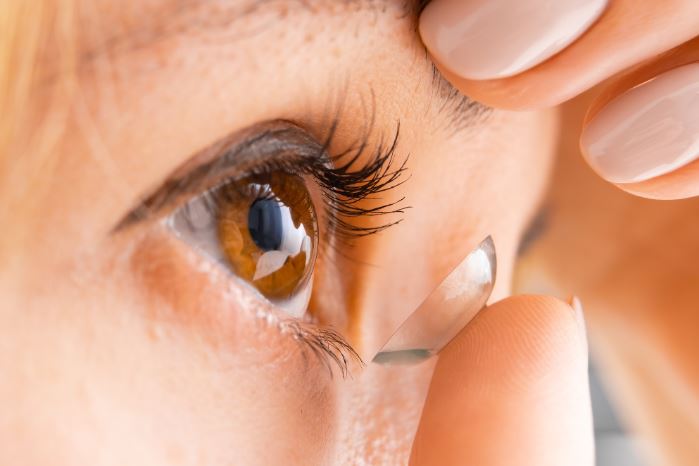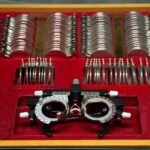Sjogren’s Syndrome and Scleral Lenses

Sjogren’s Syndrome is a chronic systemic progressive autoimmune disease that affects the body’s moisture-producing glands such as lacrimal and salivary glands. According to the Sjogren’s Foundation, approximately four million Americans have Sjogren’s Syndrome, and it is more common in women than men. The exact cause of Sjogren’s Syndrome is unknown, but research suggests that genetic and environmental factors may play a role.
Symptoms of Sjogren’s Syndrome include dry eyes, dry mouth, fatigue, joint pain, and swelling. Dry eye syndrome which is the most common symptom can cause redness, itching, burning, and blurred vision. Dry eye syndrome can lead to corneal damage and vision loss in severe cases.
Scleral Lenses: A Solution for Sjogren’s Syndrome
Scleral lenses which are made of an oxygen-permeable rigid plastic are a type of lens that covers the entire cornea and sclera, creating a tear-filled chamber that helps moisturize the eyes. Unlike traditional contact lenses which sit on the cornea, scleral lenses which have a larger diameter rest on the sclera, providing a more comfortable and stable fit.
“Contact lens” does not apply to this type of lens because there is no contact between the lens and the cornea (transparent layer in front of the eye).
Because it doesn’t make contact with the cornea surface, it creates a dome shape over it leaving a space between the lens and the front surface of the cornea. This space is filled with tears and saline (contact lens solution) to provide moisture to the cornea all day long
Advantages of Scleral Lenses for Sjogren’s Syndrome Patients
Scleral lenses offer several advantages for people with Sjogren’s Syndrome.
First, they provide a constant source of moisture to the eyes, reducing dryness and discomfort. They are designed to cover the entire cornea and sclera of the eye, creating a chamber which acts as a reservoir of tears, which helps to provide a constant source of moisture to the eye surface. Unlike traditional contact lenses, which sit on the cornea and can cause irritation or redness, scleral lenses rest on the sclera, providing a more comfortable and stable fit. The tear-filled chamber also protects the cornea from mechanical injury and damage.
Second, scleral lenses are more comfortable than traditional contact lenses because they do not touch the cornea of the eye. Instead, they rest on the sclera which is less sensitive to touch and less likely to cause irritation or redness. This makes them an excellent alternative to traditional contact lenses for people with dry eyes or other conditions that make wearing traditional contacts uncomfortable. Additionally, scleral lenses are less likely to move around or pop out of the eye, providing a more stable fit and better vision correction.
Third, People with Sjogren’s syndrome are more likely to experience vision problems than others. scleral lenses can correct vision problems such as farsightedness (hyperopia), nearsightedness (myopia), and astigmatism by altering the shape and curvature of the cornea, making them an excellent alternative to glasses or traditional contact lenses.
Types of Scleral Lenses Available for Sjogren’s Syndrome
One type is the mini-scleral lens, which covers only the cornea and a small portion of the sclera. These lenses are more comfortable than traditional contact lenses and provide some moisture to the eyes.
Another type is the full scleral lens, which covers the entire cornea and sclera. These lenses provide the most moisture to the eyes and are ideal for people with severe dry eye syndrome.
How to choose the right Scleral Lenses
Choosing the right scleral lenses depends on several factors, including the severity of dry eye syndrome, the shape of the eye, and the level of correction needed. An eye care professional can help determine the best lens type and fit it properly. The fitting process involves several appointments and steps, including measuring the eye, selecting the appropriate lens size, and adjusting the lens to ensure a comfortable fit. And the cost of scleral lenses can vary depending on your insurance coverage.
Tips for wearing and maintaining Scleral Lenses
Wearing and maintaining scleral lenses requires proper care and attention. Here are some tips to help you get the most out of your lenses:
- Follow your eye care professional’s instructions for cleaning and disinfecting your lenses.
- Avoid wearing your lenses for extended periods, as this can lead to discomfort and dryness.
- Use preservative-free eye drops to lubricate your eyes throughout the day.
- Store your lenses in a clean, dry case when not in use.
- Avoid swimming or showering with your lenses on, as this can cause infection or damage to the lenses.
In conclusion, Scleral lenses offer a promising solution for people with Sjogren’s Syndrome, as they provide a constant source of moisture to the eyes and improve vision. As technology advances, researchers are exploring new materials and designs for scleral lenses that can benefit patients with dry eye syndrome even more. The future of scleral lenses looks bright, and they may become the go-to solution
References
- Romano, V., Romano, D., Semeraro, P., Forbice, E., Iaria, A., Pizzolante, T., Frassi, M., Franceschini, F., & Semeraro, F. (2022). Therapeutic Hyper-CL soft contact lens in Sjögren’s syndrome. American journal of ophthalmology case reports, 28, 101685. https://doi.org/10.1016/j.ajoc.2022.101685
- https://www.youreyesinfocus.com/sjogren-s-syndrome
- https://www.miamicontactlens.com/6-benefits-of-scleral-lenses-for-sjogrens-syndrome/




